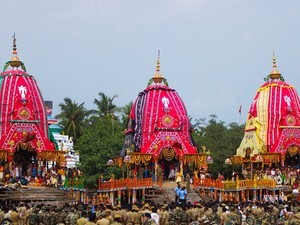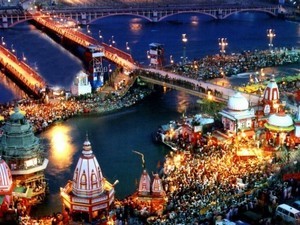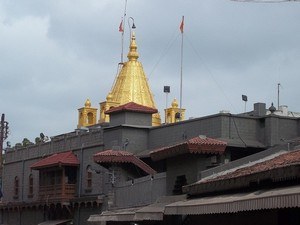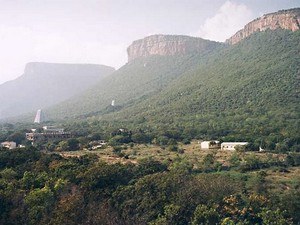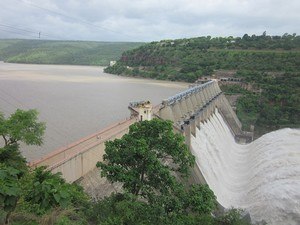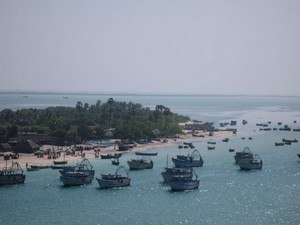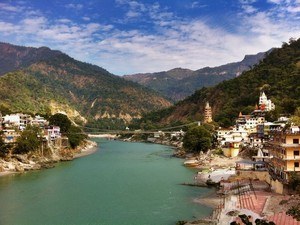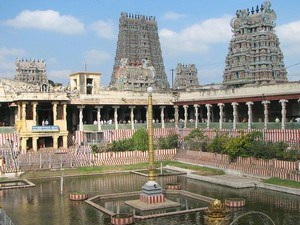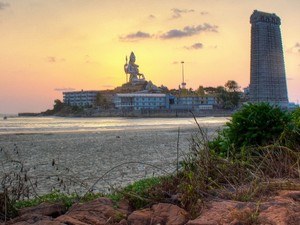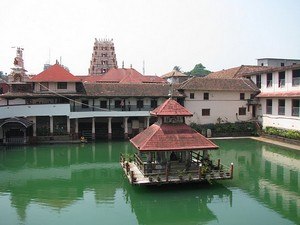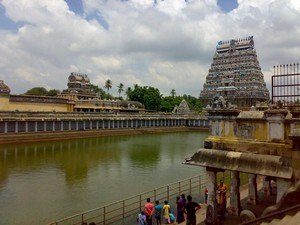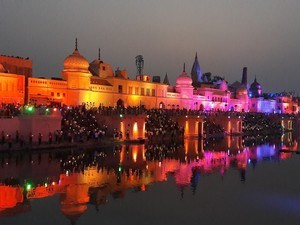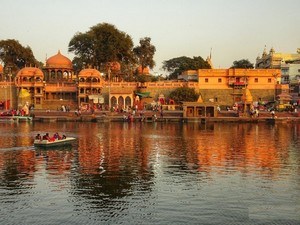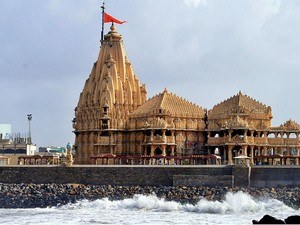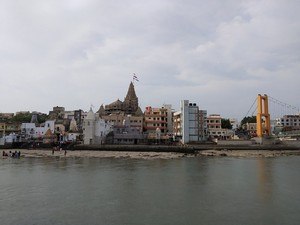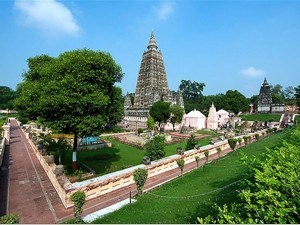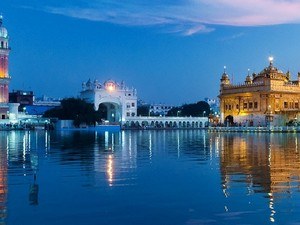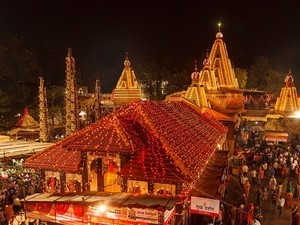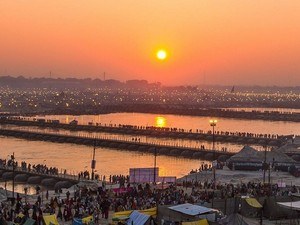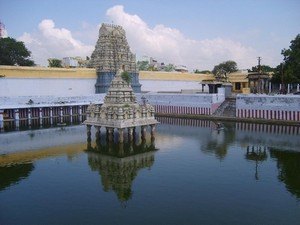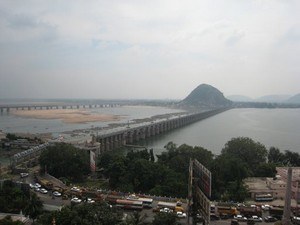1
DAY 1 : VARANASI SIGHTSEEING
DAY 1 : VARANASI SIGHTSEEING
 Sightseeing
Sightseeing
Leisure / No Sightseeing
At a distance of 5 km from Varanasi Junction, Kashi Vishwanath Temple is an ancient Hindu temple situated on the banks of River Ganga in Varanasi city of Uttar Pradesh. Popularly known as Golden Temple, it is one of the twelve jyotirlinga temples and also one of the popular places of Pilgrimage in India.
Kashi Vishwanath Temple is dedicated to Lord Vishwanath, one of the incarnations of Lord Shiva and he is regarded as the patron deity of Varanasi. The Vishwanath Jyotirlinga Temple at Varanasi has high religious significance and is the center of faith for millions of Hindus. The temple was visited by many great saints including Ramakrishna Paramhansa, Swami Vivekananda, Maharishi Dayanand Saraswati, Goswami Tulsidas, Adi Shankaracharya and Gurunanak Dev. Lord Vishwanath is considered to the supreme origin of the spiritual truth and strengthens the bonds of universal brotherhood. It is believed that a single darshan of Vishweshwara Jyotirlinga is considered to auspicious more than .....
 Duration of visit: 1 Hour
Duration of visit: 1 Hour
 Timings: 4 AM to 11 PM
Timings: 4 AM to 11 PM
At a distance of 5 km from Varanasi Junction, Annapurna Devi Mandir is a popular Hindu temple situated near Kashi Vishwanath Temple in Vishwanath Galli area of Varanasi, Uttar Pradesh. Having great religious importance in Hinduism, it is one of the popular places to visit in Varanasi.
The temple was constructed by Maratha Peshwa Baji Rao in 1729 AD. Having great religious importance in Hinduism, the temple is dedicated to Goddess Annapurna Devi, the Goddess of Food or the Goddess of Nourishment. It is believed that Goddess Parvati gave Alms to Shiva, and she is depicted with a bowl in one hand and ladle in the other, serving food to Shiva, standing in front of her with his begging bowl in the hand. Mata Annapurna is the Goddess of Varanasi who always protects Kashi and feeding her devotees.
According to the legend, the entire world becomes dark when Mata Parvati closed all the three eyes of Lord Shiva. Due to this, Mata Parvati too lost her Gauri Rupa and asked Lord Shiva's .....
 Duration of visit: 30 Mins
Duration of visit: 30 Mins
 Timings: 4 AM to 10 PM
Timings: 4 AM to 10 PM
At a distance of 1 km from Dasashwamedh Ghat and 6 km from Varanasi Junction, Manikarnika Ghat is one of the holiest ghats in Varanasi along the banks of River Ganga. Situated just beside Dasashwamedh Ghat, it is the main cremation ghat and also one of the oldest ghats in Varanasi.
Popularly called as Mahasmasana, Manikarnika Ghat is one of two burning Ghats in Varanasi while the other one is Harishchandra Ghat. According to Hindu mythology, Manikarnika Ghat is believed to be the place where the ear ornament worn by Sati fell down when Lord Shiva was carrying her to the Himalayas.
Manikarnika Ghat is among the pivotal places of interest in Varanasi. According to the religious beliefs, burning the dead bodies at this ghat is a way to attain Moksha, the salvation. The ghat also houses a Shiva Durga Temple, which was constructed by Maharaja of Awadh in 1850. Apart from this, a sacred pond named Cakra-Pushkarini is also adorning this holy place. It is believed that this pond .....
 Duration of visit: 30 Mins
Duration of visit: 30 Mins
 Timings: 24 Hours
Timings: 24 Hours
At a distance of 1 km from Dasashwamedh Ghat and 5 km from Varanasi Junction, Lalita Ghat is one of the main ghats on the Ganges River in Varanasi. This ghat is one of the most venerated ghats of Kashi for the devotees and is also identified among the seven most prominent ghats of Varanasi by Varanasi Tourism Department.
The ghat was built by King of Nepal, Rana Bahadur Shah in the early 19th century CE. The ghat is dedicated to Lalita Devi who is reckoned to be the personification of Goddess Durga. Devotees who come to this ghat believe that bathing at this ghat will earn the blessings of the Goddess.
Lalita Ghat is dotted with several Hindu temples. The well-known 'lingam' of Ganga Keshav and shrines of Gangatitya, Kashi Devi, Lalita Devi and Bhagirath Tirtha are affiliated to Lalita Ghat. Also known as Nepali Mandir, the Keshava temple was built by King of Nepal in typical Nepalese architecture. Also known as Kothwala Temple, thi is the replica of the famous Pashupatinath .....
 Duration of visit: 30 Mins
Duration of visit: 30 Mins
 Timings: Nepali Temple: 4 AM - 9 PM
Timings: Nepali Temple: 4 AM - 9 PM
BREAK FOR MEALS / HOTEL CHECK-IN | CHECK-OUT / SHOPPING / LEISURE
At a distance of 5 km from Varanasi Junction, Sri Kashi Vishalakshi Temple is a Hindu temple situated at Mir Ghat on the banks of the Ganges at Varanasi in Uttar Pradesh, India. Situated near Kashi Vishwanath Mandir, it is among the popular temples in Banaras and also one of the must visit places in Varanasi.
The temple is dedicated to Goddess Vishalakshi Devi, the divine form of Goddess Sati. This temple is one among the 51 Shakti Peethas, and is part of the famous triad of temples- Kanchi Kamakshi, Madurai Meenakshi and Kashi Vishalakshi. According to mythology, the earring of the goddess Sati has fallen on this holy spot of Varanasi. Another version says that this is a Shakti Peetha only because one of the three eyes of Goddess Sati (Akshi) fell here. As the divine eye can perceive the entire universe, Mother here is called Vishalakshi, the vast-eyed.
Sri Vishalakshi Temple is built in South Indian architectural style. The Gopuram at the entrance has elaborate carvings and .....
 Duration of visit: 30 Mins - 1 Hr
Duration of visit: 30 Mins - 1 Hr
 Timings: 4.30 AM - 11 AM & 5 PM - 10 PM
Timings: 4.30 AM - 11 AM & 5 PM - 10 PM
At a distance of 6 km from Varanasi Junction, Dasashwamedh Ghat is a ghat on the banks of River Ganga in the holy town of Varanasi. Located close to Vishwanath Temple, Dasashwamedh Ghat is one of the oldest ghats in Varanasi and also one of the popular places to visit in Varanasi.
The Dasaswamedh Ghat is one of the most important religious sites in Varanasi and is considered as the main ghat. It is believed that Lord Brahma performed his victorious Dasa_Ashwamedha (ten - horses) sacrifice in this spot, hence the name Dasashwamedh Ghat. Locals also believe that this ghat was built by Bajirao Peshwa I in 1740 AD. However, Ahilyabahi Holkar, the Queen of Indore rebuilt the ghat in the year 1774.
Dotted with numerous temples and religious sites, the ghat possesses well laid steps and platforms for performing various rituals and religious activities. Dasashwamedh Ghat is famous for Ganga Aarti at each evening which attracts many devotees and is certainly once in a lifetime experience. .....
 Duration of visit: 30 Mins - 1 Hr
Duration of visit: 30 Mins - 1 Hr
 Timings: 24 Hours, Ganga Aarti: 6.30 PM
Timings: 24 Hours, Ganga Aarti: 6.30 PM
2
DAY 2 : AYODHYA SIGHTSEEING
%%Itinerary_Title_Day2%%
 Sightseeing
Sightseeing
At a distance of 2 km from Ayodhya Junction, Ram Janmabhoomi or Ram Janam Bhoomi is a sacred place situated in Ayodhya, Uttar Pradesh. It is one of the popular temples in Uttara Pradesh, and among the must-include places in Ayodhya tour packages.
Although Ayodhya is generally referred to as the birthplace of Shri Ram, there is actually a specific place in Ram Kot Ward of the city where Lord Rama was born. Ram Janam Bhoomi is believed to have been the exact birthplace of the Hindu deity, Lord Ram. This holy place has been regarded as the first one of the seven most important pilgrimage sites for Hindus in India, and among the must visit places in Ayodhya Darshan.
The Ram Janmabhoomi site is where the famous Babri Masjid once stood. It is believed that the Mughals demolished a Hindu shrine to build this mosque at the birthplace of Lord Ram. In .....
 Duration of visit: 30 Mins - 1 Hr
Duration of visit: 30 Mins - 1 Hr
 Timings: 8 AM - 11 AM & 2.30 PM - 5.30 PM
Timings: 8 AM - 11 AM & 2.30 PM - 5.30 PM
At a distance of 1.5 km from Ayodhya Junction, Hanuman Garhi is a 10th-century Hindu temple located in the Sai Nagar area of Ayodhya, Uttar Pradesh, India. It is one of the popular temple complexes of Hanuman in North India, and among the must-include places in Ayodhya Tour.
Situated in the center of the town, the Hanuman Garhi temple is dedicated to the Hindu God, Hanuman. It is one of the most important temples in Ayodhya as it is customary to visit Hanuman Garhi before visiting the Ram Temple in Ayodhya. It is believed that Lord Hanuman lived here in a cave and guarded the Janambhoomi or Ramkot. This temple is under the administration of Bairagi Akhara named Nirvani Ani Akhara.
Built by the Nawab of Awadh, this 10th-century temple is approachable by a flight of 76 steps. A massive structure in the shape of a four-sided fort with circular bastions at each corner, the main temple houses a 6-inch-tall idol of Hanuman. The .....
 Duration of visit: 15 Mins
Duration of visit: 15 Mins
 Timings: 5 AM - 11 PM
Timings: 5 AM - 11 PM
At a distance of 2 km from Ayodhya Junction, Dasrath Bhavan is a religious place situated in Ramkot Ayodhya. It is one of the popular places to visit as part of Ayodhya Packages.
Located in the heart of the city, Dashrath Bhavan is believed to have been constructed at the same place where the original palace of King Dashrath- the ruler of Ayodhya and father to Lord Sri Rama. Lord Ram along with his siblings spent their childhood and youth in this area. Popularly known as Bada Asthan or Badi Jagah, this pretty palace hosts a decorated and ornamented entrance with beautiful paintings.
The Bhavan houses a shrine with the idols of Shri Ram, Lakshman, and Sita. Within the palace, there are saffron-clad monks chanting mantras, singing, and dancing. Although the Bhavan appears much smaller than its original counterpart where King Dasrath might have lived, the Dashrath Bhavan is a definite magnet during festivities such as Ram Vivah, Karthik Mela, Diwali, Ram Navami, and Shravan Mela.
Timings: .....
 Duration of visit: 15 Mins
Duration of visit: 15 Mins
 Timings: 8 AM - 12 PM & 4 PM - 10 PM
Timings: 8 AM - 12 PM & 4 PM - 10 PM
At a distance of 2 km from Ayodhya Junction, Kanak Bhawan is another Hindu temple located in the Tulsi Nagar area of Ayodhya. Situated to the northeast of Ram Janam Bhoomi or Ramkot, it is one of the popular temples to visit in Ayodhya as part of your Uttar Pradesh tour.
Kanak Bhawan temple is dedicated to Lord Ram and his divine consort Sita. It is believed that this building was gifted to Devi Sita by Kaikei immediately after her marriage to Lord Rama. This is the private palace of Devi Sita and Lord Rama. Vikramaditya got it renovated and was completely revamped and rebuilt by Vrish Bhanu Kunwari in 1891. This Bundela-styled temple is currently managed by the Sri Vrishbhan Dharma Setu Trust Private Limited.
This shrine is a marvelous example of Bundelkhand architecture style and is the most beautiful structure in Ayodhya. The temple's central hall boasts arched doorways on three sides and its sanctum sanctorum houses .....
 Duration of visit: 15 Mins
Duration of visit: 15 Mins
 Timings: 8 AM - 11 AM & 4.30 PM - 9 PM
Timings: 8 AM - 11 AM & 4.30 PM - 9 PM
At a distance of 3 km from Ayodhya Junction, Nageshwarnath Temple is a Hindu temple situated at Ram ki Paidi in Ayodhya. It is one of the popular temples in Ayodhya, and among the must-include places in Ayodhya Darshan packages.
Located adjacent to the Theri Bazaar, Nageshwarnath Temple is dedicated to Lord Shiva who is also known as Nageshwar Nath or Lord of Snakes. The sanctum sanctorum of the temple houses a beautiful Shiva lingam. The temple is believed to have been established by Kush, the younger son of Lord Rama. According to a legend, Kush lost his armlet while taking a bath in the Sarayu River. He tried to find it but did not succeed. It was finally retrieved by Naag-Kanya, who was a devotee of God Shiva. As a gesture of gratitude, Kush built Nageshwarnath Temple. It is believed that the temple survived in good shape until the reign of Chandragupta Vikramaditya even though the rest of the city was turned into ruins. It .....
 Duration of visit: 15 Mins
Duration of visit: 15 Mins
 Timings: 5 AM - 8.30 PM, Aarti: 5 AM - 6 AM & 8 PM - 8.30 PM
Timings: 5 AM - 8.30 PM, Aarti: 5 AM - 6 AM & 8 PM - 8.30 PM
At a distance of 3 km from Ayodhya Junction, Ram ki Paidi is a series of ghats on the bank of River Saryu in the holy city of Ayodhya. It is one of the many ghats on the banks of the Sarayu River, and among the top places of sightseeing in Ayodhya.
Ram ki Paidi is actually a flight of steps on Nayaghat near the bank of the Saryu River where huge crowds of pilgrims and the devotees take a bath in the holy waters of the river. The original steps were washed away by the strong currents of the river. A new ghat with the steps was constructed by the joint effort of the then Chief Minister of UP, Shri Shripati Mishra, and his irrigation minister Shri Vir Bahadur Singh during the period 1984-1985.
The water for the ghat is lifted with motor pumps from the Saryu river. The maintenance of the ghats and the regular supply of water is managed by the Flood Works Division of the Irrigation Department. It .....
 Duration of visit: 30 Mins
Duration of visit: 30 Mins
 Timings: 24 Hours
Timings: 24 Hours
At a distance of 3 km from Ayodhya Junction, Ram Katha Park is a beautiful park situated on the banks of the Sarayu River in Ayodhya. It is one of the popular places to visit during your Ayodhya Trip.
Ram Katha Park is a beautiful, spacious, and well-maintained park that provides much-needed solace from the crowds of the town. The park has open-air theatres and well-kept lawns. Spread over a vast area of land, it is a popular venue for devotional programs, cultural performances, religious events, and Katha recital sessions. It also offers opportunities to budding artists, both local and outsiders, to showcase their talent in theatrical performances, dance, music, and poetry. The park is a popular leisure destination for visitors of all age groups who spend their evenings and weekends in a spiritually charged environment.
Ayodhya, being the birthplace of Shri Ram, remains heavily crowded with pilgrims and tourists all through the year. Although the city boasts of a large number .....
 Duration of visit: 30 Mins - 1 Hr
Duration of visit: 30 Mins - 1 Hr
 Timings: 6 AM - 7 PM
Timings: 6 AM - 7 PM

